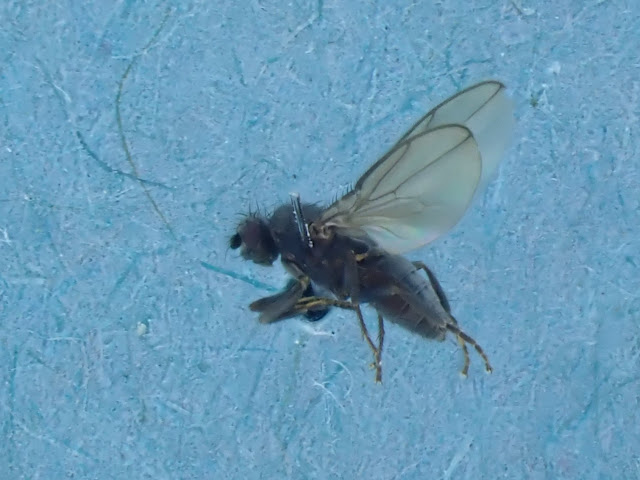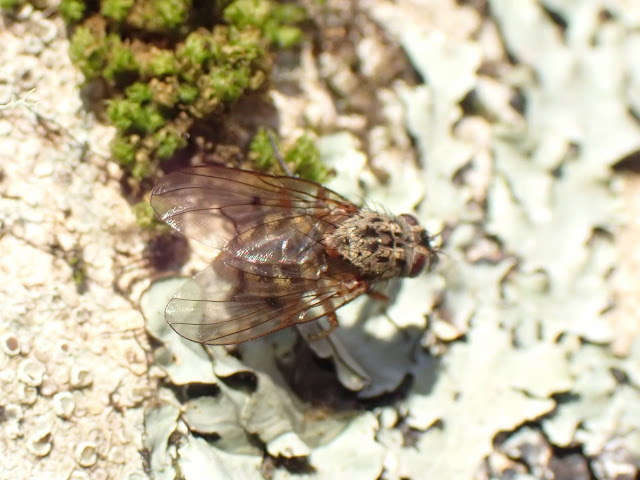Today I took myself down to the large pile of pebbles that is Earlish beach with the intention of finding Kelp Flies (Coelopa sp). With the wind being a mere breeze from the north, I rather fancied my chances of success. Despite being only a couple of miles away from where I live, this was only the second time I'd been here, following on from this visit back in January. Here's the view from the top
 |
| The name of this bay is Camas Beag which is Scots Gaelic for Little Cove |
The trail down wasn't quite as slippery as last time I was here and within a few minutes I was at sea level taking this short clip. You can see the ferry berthed at Uig Pier, and its onward destination the Outer Hebrides on the horizon across The Minch.
Strewn along the top of the beach was a decomposing line of wrack which I worked for about a hundred metres. Lots and lots of beach hoppers, but the only flies seemed to be very small sphaerocerids with no sign of the hoped for Coelopa at all. Darnit. Again. Here's a pic of one of the two sphaerocerids I retained, the whole fly is all of about 2mm in length. I haven't run it through the key yet, but I usually manage to identify any sphaero's I find without too much difficulty. I've probably just jinxed myself by saying that...
Next day edit - they are both Thoracochaeta zosterae, which is the same species of sphaerocerid I swept from here in January.
 |
| Thoracochaeta zosterae - a common fly in piles of decomposing seaweed |
I swiped at a larger fly and was rather surprised to find myself eye-balling a Sylvicola. Soon after that I swept a second individual, both were females. Back indoors afterwards I did a little reading up and learned that their larvae are to be found in almost any type of decomposing vegetable matter, so maybe I oughtn't to have been so surprised after all.
 |
| Sylvicola cinctus - the commonest window gnat I encounter on Skye |
Quitting the wrack line I started checking beneath stones and debris in the strip of short turf above the beach. Beneath one log I found a greyish dungfly and quickly popped it into a tube. Another bit of debris had two dungflies hiding beneath, they too were quickly potted up. One individual was noticeably paler than the other two and a quick look through the hand lens proved beyond a doubt that it was a teneral individual.
 |
| Darkly coloured body parts and wing veins - this is a mature adult fly |
 |
| Pale body parts, insipid wing veins and...what the heck is going on with its face??? |
When a fly first emerges from its pupa it is soft and pale-coloured. The cuticle slowly hardens and the wings gradually unfurl, expand and harden too. At the same time the body pigments are laid down, the whole process can take quite a few hours depending on the species involved. This individual is only partway through that process, the wings have fully expanded and some colour has been laid down, but it has yet to finish maturing.
And the reason behind that huge bulb on the face? That's the best bit! Some flies (the calyptrate and acalyptrate families) have an inflatable pouch on the front of their head. This pouch serves just one purpose - when fully inflated the outward pressure it exerts bursts open the pupal case, allowing the soft-bodied fly within to crawl out. Once the fly has escaped the pupal case, it goes about the process of hardening up and expanding the wings and this pouch, termed the ptilinum, is slowly deflated until it fits into a small fold between the eyes, eventually all that remains to be seen externally is the ptilinal suture. This deflating may take some time, so a recently emerged (teneral) fly may still exhibit this bulge on its forehead which is what you can see in the image above. The first time I saw this was only a year or two back; I had reared out some leaf-mining flies and, through a 10x hand lens, I could see that one of my flies had a massively enlarged head that seemed to throb in and out - it really freaked me out at the time as I had no idea what I was seeing. I think I half-expected a disgusting parasite to burst out from within! I'm not convinced my knowing what is happening puts me in much of a better position, it still seems a completely alien freaky process if you ask me. Amazing yes, but highly freaky all the same.
I retained three dungflies in total, there are a couple of very close lookalike species otherwise I would only have taken one to key through. Here they are for you, just check the hairiness of the hind femora!
 |
| One of these flies is the teneral individual - spot it yet? |
All three flies are male Scathophaga calida, a common seashore species on Skye. I find this on my local beach here in Uig, so it's hardly surprising that it should be here too just a couple of miles away. I'm not entirely happy with my choice of background colour for these images, I'll have to find something a bit more neutral toned and without a pattern to it.
The weather has finally turned warmer. The forecast is for a pretty constant 8C air temperature for the coming week, combined with a bit of rain and hardly any chance of sunshine, but it seems the cold has finally moved on - huzzah! Another couple of weeks time and I'll be on the look out for the first Gymnocheta viridis of the year sat on a sunlit tree trunk. I can hardly wait - in my book the sight of a green-glinted Gymnocheta is the first proper sign that spring has finally sprung!

















